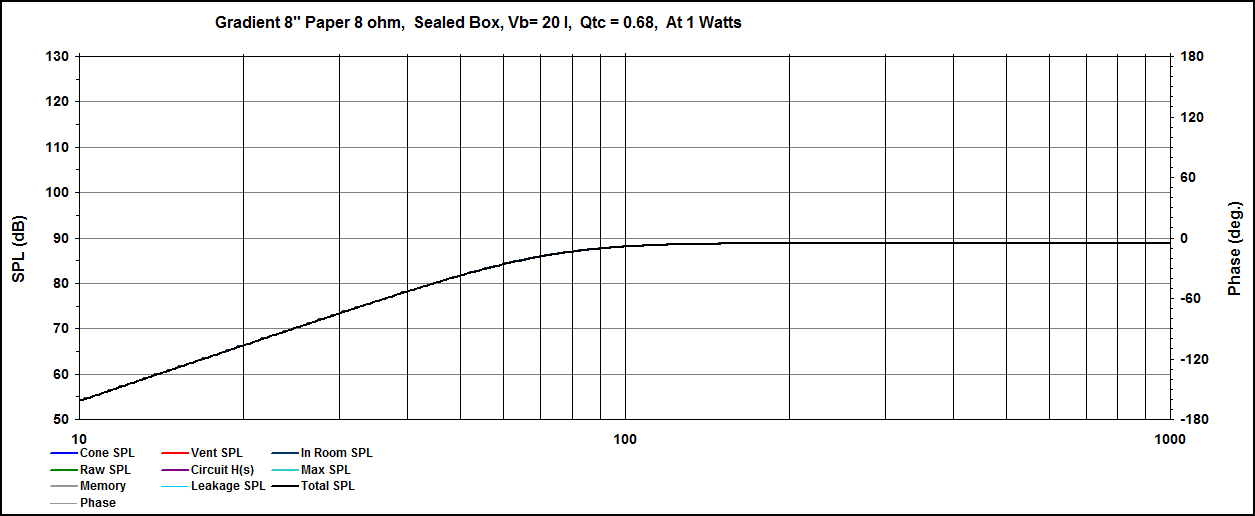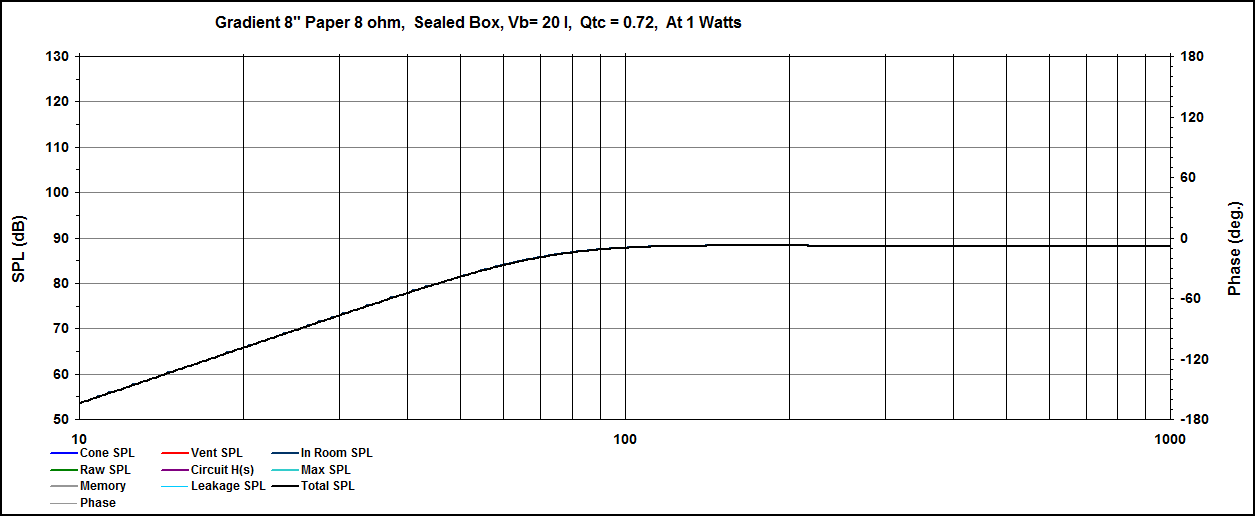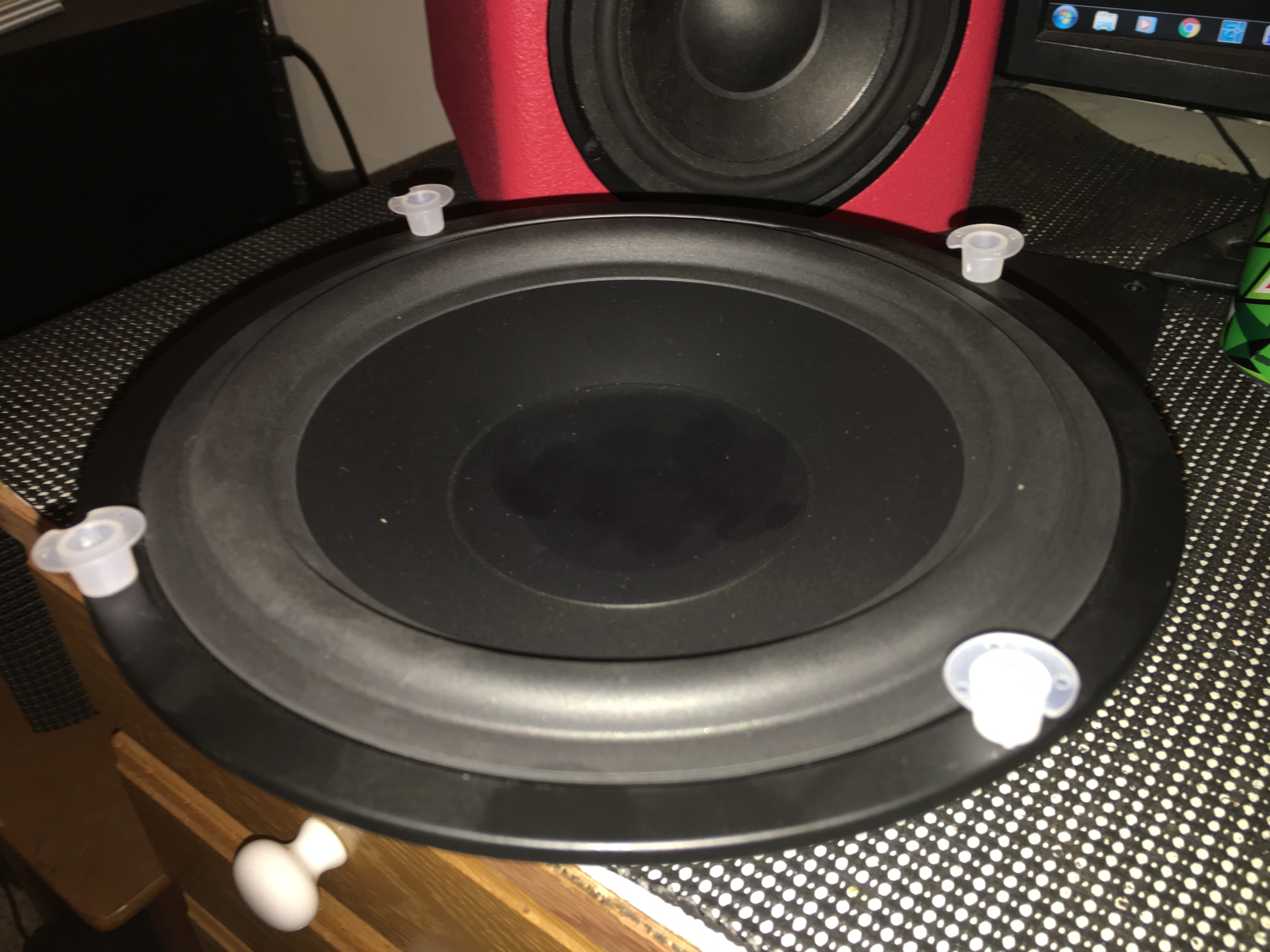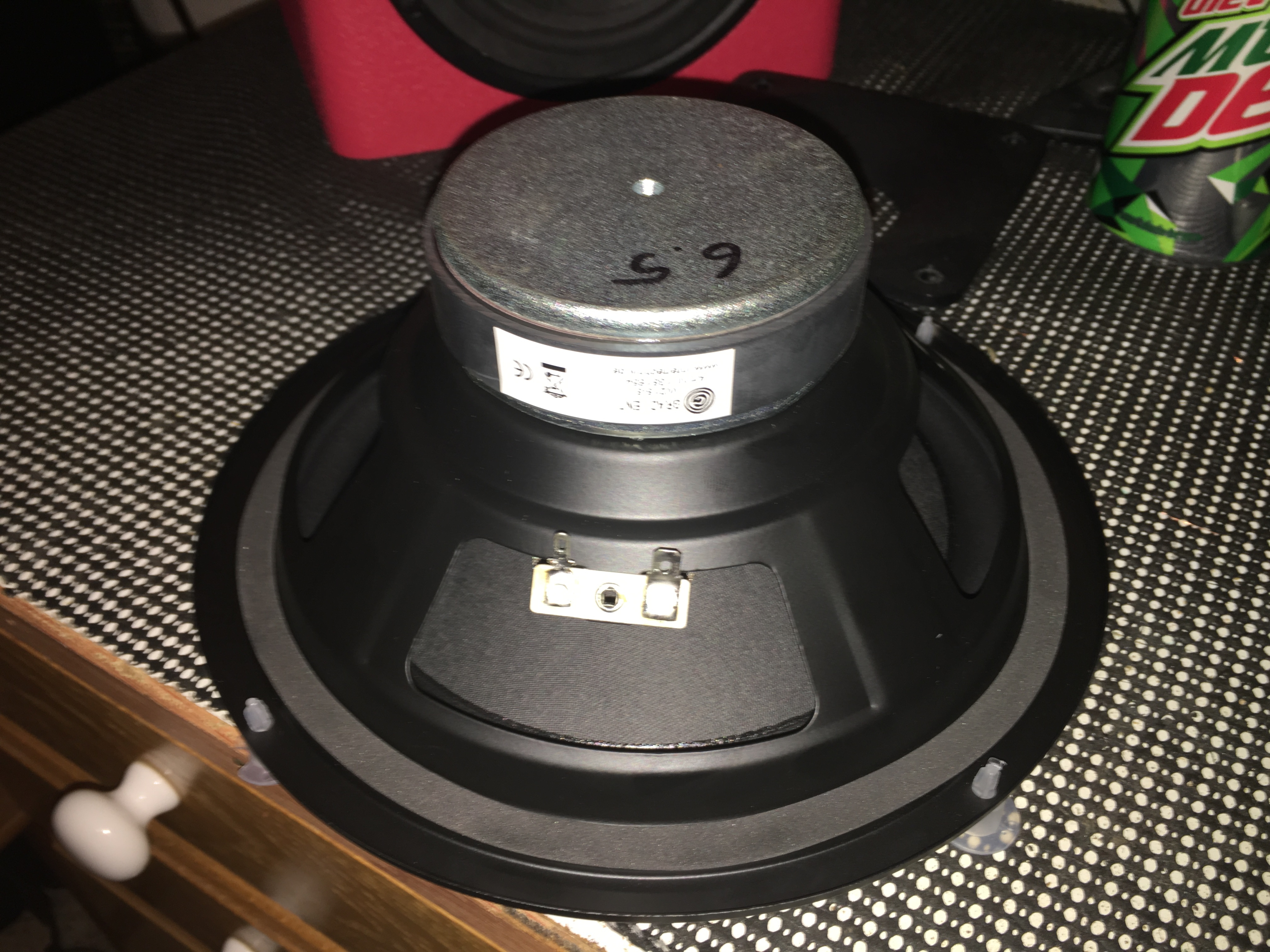Site Links
Howdy, Stranger!
It looks like you're new here. If you want to get involved, click one of these buttons!
Quick Links
Categories
Who's Online (0)
Gradient Acoustics Select 8" Paper Cone Woofer 8 ohm (P/N 55-5580)
Here we have a no frills, treated paper cone woofer distributed by MCM. Stamped frame, the treatment on the pressed paper cone is poly-ish looking - not at all unattractive. Not a fan of the concave dustcap, but that is just a personal preference.
Looking at the impedance curve, we see squigglies at 140, 1000, 2800, 3500, and 4800. This woofer probably has some erratic response issues starting at 1K - but getting it on a baffle will tell the tale. Given the blip at 1K however, pretty decent odds this is not an ideal candidate for 2-way use. Good thing I plan on a 3-way with it

I broke the driver in by hand, and was able to bottom the voice coil out against the back plate. This is due to the lack of a bumped back plate, but also due to soft parts that do not arrest the cone in time. I am starting to suspect this is due to the very common usage of 1/2" rolled surrounds on most 6.5" and larger drivers - it allows a lot of mechanical throw and is quite likely a very cost effective solution. While a 3/8" surround might not look as "beefy", on these types of drivers lacking a bumped back plate it would be a better choice.
Xmax is not advertised, but given the price point and construction - 3-4mm is likely the upper limit. It appears to have better than 10mm of mechanical throw before bottoming out, however. If it had a bigger motor, saturation alone might allow for a cleaner sound when it jumps the gap - on this driver, however, the "uglies" will likely have someone reaching for the volume control before finding that Xmech limit. For modeling purposes, using 3.5mm will probably yield satisfactory results.
T/S measured (advertised)
Looking at the impedance curve, we see squigglies at 140, 1000, 2800, 3500, and 4800. This woofer probably has some erratic response issues starting at 1K - but getting it on a baffle will tell the tale. Given the blip at 1K however, pretty decent odds this is not an ideal candidate for 2-way use. Good thing I plan on a 3-way with it

I broke the driver in by hand, and was able to bottom the voice coil out against the back plate. This is due to the lack of a bumped back plate, but also due to soft parts that do not arrest the cone in time. I am starting to suspect this is due to the very common usage of 1/2" rolled surrounds on most 6.5" and larger drivers - it allows a lot of mechanical throw and is quite likely a very cost effective solution. While a 3/8" surround might not look as "beefy", on these types of drivers lacking a bumped back plate it would be a better choice.
Xmax is not advertised, but given the price point and construction - 3-4mm is likely the upper limit. It appears to have better than 10mm of mechanical throw before bottoming out, however. If it had a bigger motor, saturation alone might allow for a cleaner sound when it jumps the gap - on this driver, however, the "uglies" will likely have someone reaching for the volume control before finding that Xmech limit. For modeling purposes, using 3.5mm will probably yield satisfactory results.
T/S measured (advertised)
Fs = 39.09 Hz (38)
Re = 6.50 ohms[dc] (unknown)
Le = 279.96 uH (unknown)
L2 = 807.66 uH (unknown)
R2 = 24.38 ohms (unknown)
Qt = 0.45 (0.5)
Qes = 0.51 (1.05)
Qms = 3.67 (3.7)
Mms = 23.06 grams (unknown)
Rms = 1.544159 kg/s (unknown)
Cms = 0.000719 m/N (unknown)
Vas = 46.16 liters (44.9)
Sd= 213.82 cm^2 (unknown)
Bl = 8.503685 Tm (unknown)
ETA = 0.52 % (unknown)
Lp(2.83V/1m) = 90.17 dB (87*)
Added Mass Method:
Added mass = 35.00 grams
Diameter= 16.50 cm
* Advertised is 1W/1M which is pretty close to the measured of 2.83V/1M
As you can see, reasonably close to advertised - remarkably close given the price point and overall outward appearance - it *looks* like a budget driver. The Qts with such a small motor indicates good, tight fit of the voice coil in the gap. Suspension is slightly loosey-goosey - if the Qts were actually higher, it would be a perfect fit for old school Acoustic Suspension alignments.
A few alignments (modeled using 0.5 ohm series resistance)
30L vented, tuned to 40Hz, F3/6/10 of 52/40/32:

20L vented, tuned to 50Hz, F3/6/10 of 62/50/40:

20L sealed, Q of 0.68 (modeled with Qa value of 10), F3/6/10 of 68/53/41:

Sooo... a moderately sized, sealed enclosure of 20L (0.7 cubic feet) yields a decent alignment - especially if one were to expect some boundary reinforcement. No, it probably won't give you the chest slam effect, but my experience has been getting below 70Hz with a sealed Q of around 0.7 yields a very satisfying "thump" and can fool the listener into thinking the bass is lower and louder than the simplified charts would indicate. My inclination is to go sealed with these.
For sss's and ggg's, here is a model with 1ohm of series resistance in the same 20L sealed:

F3/6/10 drops a few Hz to 67/52/40. That may or may not be noticable during listening. In fact, the difference between the 0.5 and 1.0ohm series resistance is less than 1db across the passband - it might be worth using a cheaper, high gauge air core as the primary woofer coil on these. If, in this example, one were to use the Jantzen 4.0mH 20awg air core (it has a DCR of 2ohms), F3/6/10 are subsequently 64/51/40 - along with the loss of another 1/2db or so of sensitivity across the pass band. In the case of this woofer, the relatively high sensitivity lends itself to these kinds of passive boost circuits.
While not obvious on the surface, tinkering with different gauge inductors is actually demonstrating Hoffmans law - in this case the size is the constant, leaving us to decide between loud or low. I love this hobby.
It is actually not at all unattractive as far as all that goes. The cosmetic frame, rubber surround, and clean looking poly coating give it some curb appeal. The frame is plenty flimsy - I suspect heavy duty stamped frames are dinosaurs these days.

There is a bead of what may be dampening around the outer edge of the cone, but my guess is it is actually adhesive squeeze out. No useful venting on the small 25mm voice coil, so the advertised 90w power handling is likely to be wildly, perhaps even criminally optimistic. Good thing for most of us that we tend to spend our lives in the 1-4W range. Also a good thing that thermal power handling is just a marketing term for people who do not understand mechanical power handling. Watts sells speakers.

All in all, a decent alternative to the Dayton Classic 8" - sacrifice a little bottom end performance for better looks and quite possibly smoother performance through the midrange (depending on what those wrinkles in the Z curve are representative of). Until such time as I can get some FR and distortion measurements, I cannot for certain state this is or is not a super value, based on modeling I *can* state* it is a driver worth considering at the price point.
http://www.mcmelectronics.com/product/55-5580
* Advertised is 1W/1M which is pretty close to the measured of 2.83V/1M
As you can see, reasonably close to advertised - remarkably close given the price point and overall outward appearance - it *looks* like a budget driver. The Qts with such a small motor indicates good, tight fit of the voice coil in the gap. Suspension is slightly loosey-goosey - if the Qts were actually higher, it would be a perfect fit for old school Acoustic Suspension alignments.
A few alignments (modeled using 0.5 ohm series resistance)
30L vented, tuned to 40Hz, F3/6/10 of 52/40/32:

20L vented, tuned to 50Hz, F3/6/10 of 62/50/40:

20L sealed, Q of 0.68 (modeled with Qa value of 10), F3/6/10 of 68/53/41:

Sooo... a moderately sized, sealed enclosure of 20L (0.7 cubic feet) yields a decent alignment - especially if one were to expect some boundary reinforcement. No, it probably won't give you the chest slam effect, but my experience has been getting below 70Hz with a sealed Q of around 0.7 yields a very satisfying "thump" and can fool the listener into thinking the bass is lower and louder than the simplified charts would indicate. My inclination is to go sealed with these.
For sss's and ggg's, here is a model with 1ohm of series resistance in the same 20L sealed:

F3/6/10 drops a few Hz to 67/52/40. That may or may not be noticable during listening. In fact, the difference between the 0.5 and 1.0ohm series resistance is less than 1db across the passband - it might be worth using a cheaper, high gauge air core as the primary woofer coil on these. If, in this example, one were to use the Jantzen 4.0mH 20awg air core (it has a DCR of 2ohms), F3/6/10 are subsequently 64/51/40 - along with the loss of another 1/2db or so of sensitivity across the pass band. In the case of this woofer, the relatively high sensitivity lends itself to these kinds of passive boost circuits.
While not obvious on the surface, tinkering with different gauge inductors is actually demonstrating Hoffmans law - in this case the size is the constant, leaving us to decide between loud or low. I love this hobby.
It is actually not at all unattractive as far as all that goes. The cosmetic frame, rubber surround, and clean looking poly coating give it some curb appeal. The frame is plenty flimsy - I suspect heavy duty stamped frames are dinosaurs these days.

There is a bead of what may be dampening around the outer edge of the cone, but my guess is it is actually adhesive squeeze out. No useful venting on the small 25mm voice coil, so the advertised 90w power handling is likely to be wildly, perhaps even criminally optimistic. Good thing for most of us that we tend to spend our lives in the 1-4W range. Also a good thing that thermal power handling is just a marketing term for people who do not understand mechanical power handling. Watts sells speakers.

All in all, a decent alternative to the Dayton Classic 8" - sacrifice a little bottom end performance for better looks and quite possibly smoother performance through the midrange (depending on what those wrinkles in the Z curve are representative of). Until such time as I can get some FR and distortion measurements, I cannot for certain state this is or is not a super value, based on modeling I *can* state* it is a driver worth considering at the price point.
http://www.mcmelectronics.com/product/55-5580
I have a signature.

